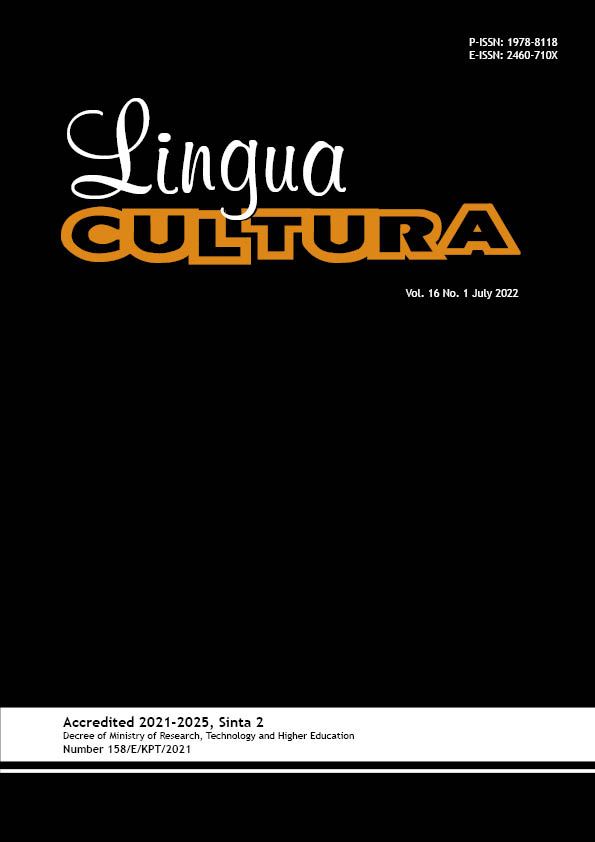A Sociolinguistic Analysis of Addressee Terms Found in Babad Banjoemas Wirjaatmadjan
DOI:
https://doi.org/10.21512/lc.v16i1.7730Keywords:
sociolinguistics , addressee term, Babad Banjoemas WirjaatmadjanAbstract
The research aimed to explain the addressee term found in Babad Banjoemas Wirjaatmadjan from a sociolinguistic point of view. This chronicle employed various kinds of addressee terms in Banyumas society. The method used is descriptive qualitative as it analyzed the variety of addressee terms and the social context of their use in a chronicle. The research results show five classifications of addressee terms found in Babad Banjoemas Wirjaatmadjan. They are (1) addressee terms that are related to the Dutch military, (2) addressee terms that are related to the position in the Indonesian government, (3) addressee terms that are related to descendants, (4) addressee term that is related to an object or thing, and (5) addressee term that is related to religion. These addressee terms are influenced by social factors such as the position in government (superior or inferior) and the aristocratic descendant.
Â
References
Al-Qudah, M. (2017). The Jordanian terms of address: Asocio-pragmatic study. SHS Web of Conferences, 37, 1-10. https://doi.org/10.1051/shsconf/20173701080.
Bisilki, A. K. (2017). Bisilki: A sociolinguistic analysis of kinship terms in Likpakpaln (Konkomba). Ghana Journal of Linguistics, 6(3), 33-58. https://doi.org/10.4314/gjl.v6i3.2.
Buliali, J. L., Johan, F., & Fetriah, D. (2007). Sistem berbasis pengetahuan untuk kenaikan militer TNI AU. Jurnal Informatika, 8(1), 18-28. https://dx.doi.org/10.9744/informatika.8.1.pp.%2018-28.
Darban, A. A. (1998). Bangsawan Jawa dalam Struktur Birokrasi Majapahit. Jurnal Humaniora, 9, 96-100. https://doi.org/10.22146/jh.2033.
Fauliyah, S. (2012). Translation of address term in “Ketika Cinta Bertasbih II†(Indonesian-English subtitle). Anglicist, 1(2), 29-35.
Hadiati, C. (2019). Felicity conditions of the speech acts in Banyumasan daily conversation. Theory and Practice in Language Studies, 9(6), 700-705. https://doi.org/10.17507/tpls.0906.13.
Halidi, M. H. M. (2019). Penggunaan kata sapaan Bahasa Gorontalo. Jurnal Bahasa dan Sastra, 4(4), 44-55.
Iriyansah, M. R. (2017). Sistem sapaan kerabat Keraton Surakarta Hadiningrat. FON: Jurnal Pendidikan Bahasa Dan Sastra Indonesia, 11(2), 1-16. https://doi.org/10.25134/fjpbsi.v11i2.719.
Oki, E. (2018). The Polish superheroes have arrived! On the popularity of superhero stories and adaptations. European Journal of American Studies, 13(3), 1-12. https://doi.org/10.4000/ejas.13678.
Pujiati, T. (2017). Penggunaan bentuk sapaan berdasarkan perspektif gender pada mahasiswa program studi Sastra Indonesia Universitas Pamulang: Kajian Sosiopragmatik. Jurnnal Sasindo Unpam, 5(2), 1-17. http://dx.doi.org/10.32493/sasindo.v5i2.%25p.
Purwokartun, N. (2020a). Babad Banyumas: Serat Babad Banyumas Wirjaatmadjan. Jakarta: Balai Pustaka.
Purwokartun, N. (2020b, October 14). Babad Banyumas 16: Raden Baribin Pandita Putra. Retrieved from https://Nassirunpurwokartun.Wordpress.Com/2020/10/14/Baribin-Pandita-Putra/.
Rahmadani., & Wahyuni, D. (2018). Types and functions of address terms used by IPMK-SB “Kampar students studying in Padangâ€. E-Journal English Language and Literature, 7(1), 132-142. https://doi.org/10.24036/ell.v7i1.9906.
Rifai, D. M., & Prasetyaningrum, S. T. (2016). A sosiolinguistic analysis of addressing terms used in Tangled movie manuscript. Jurnal Penelitian Humaniora, 17(2), 123-134. https://doi.org/10.23917/humaniora.v17i2.2504.
Rusbiyantoro, W. (2011). Penggunaan kata sapaan dalam Bahasa Melayu Kutai. Parole: Journal of Linguistics and Education, 2(1), 59-76. https://doi.org/10.14710/parole.v2i1%20April.59-76.
Saptanto, D. D., & Dewi, M. K. (2020). Gundala and Gatotkaca in the concept of modern Indonesian superheroes: Comparative analysis of the Indonesian and American superheroes. EduLite: Journal of English Education, Literature and Culture, 5(1), 59-76. https://doi.org/10.30659/e.5.1.136-147.
Shalihah, M. (2019). A pragmatic analysis on the types and the purposes of address terms used by the main character in Jane Austen’s “Emmaâ€. EnJourMe (English Journal of Merdeka): Culture, Language, and Teaching of English, 3(2), 52-60. https://doi.org/10.26905/enjourme.v3i2.2747.
Sidemen, P. (2019). Perangkat pemujaan Sulinggih Saiwa, Baudha, Bhujangga Wasinawa. Denpasar: UNHI Press.
Syahidawati, N. M. N., & Parmawati, A. (2020). A sociolinguistics analysis of addressing term used in “Aisyah: Biarkan Kami Bersaudara†movie. PROJECT (Professional Journal of English Education), 3(3), 354-358. https://doi.org/10.22460/project.v3i3.p354-358.
Tauchid, A. (2018). In search of address terms in novel. Loquen: English Studies Journal, 11(2), 15-28. https://doi.org/132678/loquen.v11i02.1278.
Wibowo, R. M., & Retnaningsih, A. (2015). Dinamika bentuk-bentuk sapaan refleksi sikap berbahasa masyarakat Indonesia. Humaniora, 27(3), 269-282. https://doi.org/10.22146/jh.10587.
Zaman, M. N., Nababan, M. R., & Djatmika. (2018). The honorifics expressions in indigenous language of Java island ethnics with relevance into English. LiNGUA: Jurnal Ilmu Bahasa dan Sastra, 13(2), 1-14. http://dx.doi.org/10.18860/ling.v13i2.5258.
Downloads
Published
How to Cite
Issue
Section
License
Copyright (c) 2022 Chusni Hadiati, Rosdiana Puspita Sari, Usep Muttaqin

This work is licensed under a Creative Commons Attribution-ShareAlike 4.0 International License.
Authors who publish with this journal agree to the following terms:
a. Authors retain copyright and grant the journal right of first publication with the work simultaneously licensed under a Creative Commons Attribution License - Share Alike that allows others to share the work with an acknowledgment of the work's authorship and initial publication in this journal.
b. Authors are able to enter into separate, additional contractual arrangements for the non-exclusive distribution of the journal's published version of the work (e.g., post it to an institutional repository or publish it in a book), with an acknowledgment of its initial publication in this journal.
c. Authors are permitted and encouraged to post their work online (e.g., in institutional repositories or on their website) prior to and during the submission process, as it can lead to productive exchanges, as well as earlier and greater citation of published work.
USER RIGHTS
All articles published Open Access will be immediately and permanently free for everyone to read and download. We are continuously working with our author communities to select the best choice of license options, currently being defined for this journal as follows: Creative Commons Attribution-Share Alike (CC BY-SA)


















